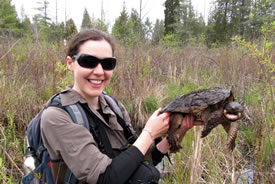#HowToNature series: How to canoe
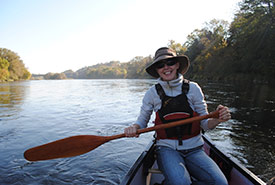
Jennifer McCarter canoeing on the Grand River (Photo by Gabhan Chalmers).
Canoeing is a quintessentially Canadian way to travel and experience the landscape (indeed, it was the primary mode of transportation and trade for the First Nations and early European settlers in North America).
There’s nothing like being on the water in a canoe. Canoeing offers:
- A totally different perspective of the landscape than from on shore;
- A great way to travel, using nothing but your own body power;
- Possibilities of close encounters with wildlife, including iconic Canadian wildlife such as loons, beavers and moose;
- A chance to enjoy the relaxing sound of the water lapping against the canoe’s hull and off your paddle with each paddle stroke;
- A good workout and technical challenge (for the more experienced, adventurous paddlers)!
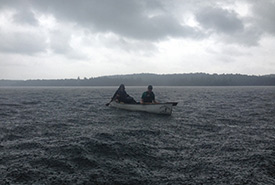
Canoeing builds character: Me and my husband, Gabhan Chalmers, were caught in a fall storm in Algonquin Park (Photo by Daniel Scott).
I have been fortunate to have the opportunity, since a young age, to enjoy many areas of Canada by canoe. My parents tell me that I was in a life-jacket, tucked into the bow of their canoe, at just three months old! Since then I’ve canoed many lakes, rivers and wetlands of Ontario for pleasure, for summer jobs and while working for NCC. I even had the chance to canoe the remote Yukon and Teslin rivers when I was in high school, following the paddle strokes of those lured by gold.
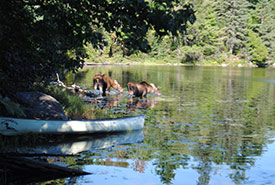
Canoeing into remote areas can put you up close and personal with wildlife. This pair of moose started feeding beside our canoe while we were on shore in Algonquin Provincial Park (Photo by Jennifer McCarter/NCC staff).
Canoeing has greatly enriched my life and my experience of the Canadian wilderness and I highly recommend canoeing to anyone who is looking to enjoy the outdoors in a new way. Here are some tips if you are interested in trying canoeing for the first time:
- Start by renting a canoe for a few hours from a local outfitter, canoe rental company or conservation authority.
- Pick a day where the forecast is for good weather with little to no wind (early morning and early evening are often calm).
- Choose a calm lake or very slow-moving river where you can get used to being in the canoe without large waves or current to worry about.
- Try it out with a friend: It’s easiest to canoe with two people – one person in the front/bow and one in the back/stern (canoeing can be done as a solo activity, but it takes a bit more experience and skill to manoeuvre a canoe by yourself).
- To help stabilize the canoe, the bow and stern paddlers should paddle on opposite sides of the canoe.
- The person in the stern steers the canoe (for more information on the most important strokes to learn, check out this summary of paddle strokes).
- Play around with your paddle and try to get a feel for what your canoe does when you move your paddle in different ways in the water.
- Stick close to shore until you feel able to control, steer and stop the canoe.
- Consider taking canoe lessons: Learning the various paddle stokes will greatly improve your efficiency (important on longer trips!) and ability to accurately manoeuver the canoe. Many organizations, including local outfitters local canoe clubs offer courses for canoeists of all levels.
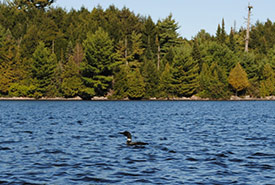
Up close and personal with a loon in Algonquin Provincial Park (Photo by Gabhan Chalmers).
Additional things to remember while canoeing:
- Be safe: Always wear a life-jacket/personal floatation device (PFD). Also bring an extra paddle (they do break or get away from you!), bail bucket, rope and whistle.
- Keep all the weight in the canoe low and centered along the length of the canoe to stay balanced.
- While you’re on the water, you’re exposed to the full sun plus the sun reflecting off the water, so cover up, wear sunglasses, a hat and sun-block to avoid getting burned.
- Store all your valuable things (wallet, phone, camera, etc.) in a waterproof bag.
- Strap or tie all your bags to the canoe so that in the unlikely event that you tip, your things don’t sink.
- Be prepared to get your feet wet while getting in and out of the canoe. You can wear old shoes or sandals, purchase cheap water shoes or go barefoot!
If you find you enjoy canoeing, you can work towards taking longer trips and eventually head out for more remote trips, multi-day back-country trips or even tackle river or white-water canoeing. Wherever canoeing takes you, I hope you enjoy it as much as I do!

